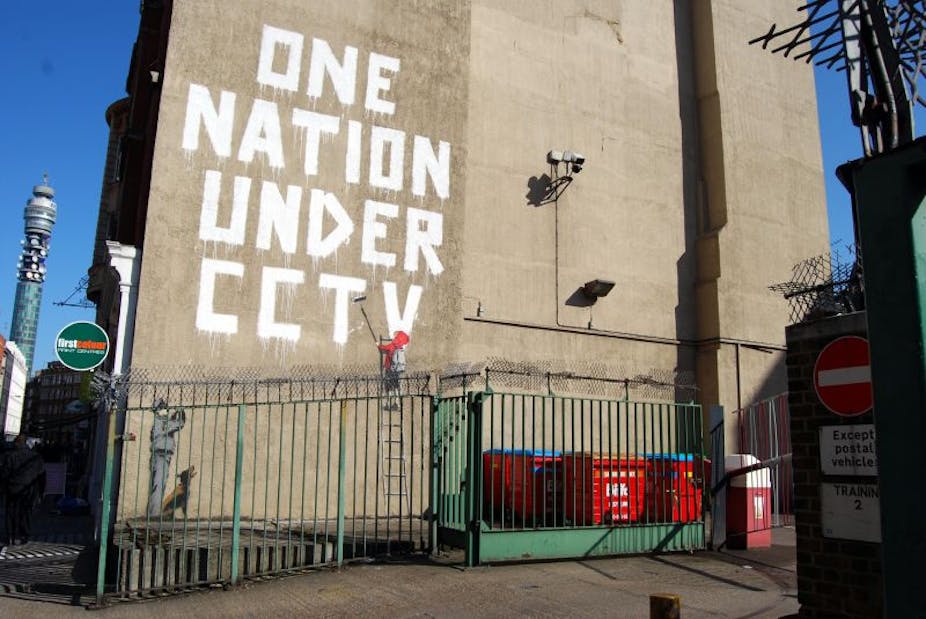In the late 1970s I found myself wandering the mostly deserted streets of East Berlin, having successfully negotiated Checkpoint Charlie and a horde of East German border guards. I remember commenting to my companions at the time the great difference between that repressive nation and the world that we had grown up in was the level of surveillance.
We would never want to live in a world, we agreed, where suspicious eyes followed us going about our daily affairs. Fast forward thirty years, and the citizens of the “free” world now find themselves under far more pervasive visual scrutiny than the burghers of East Berlin ever did. Closed circuit television (CCTV) cameras are now taken for granted throughout the world.
The UK-based CCTV User Group estimated in 2008 that there were around 420,000 such cameras in London alone, and perhaps 1.5 million cameras in the United Kingdom. That was five years ago. Numbers have grown exponentially since then. In fact, since many of these cameras are privately owned, no one actually has any idea how many cameras there are in any city at any given time.
The latest instalment in the surveillance stakes are “unmanned airborne vehicles” (UAVs), sometimes referred to as “drones”. Originally aircraft-sized, and designed solely for military purposes, small drones are now available to the public for about $10,000. A “toy” drone can even be purchased for under $200.
Inside what appears to be a model aircraft is a sophisticated camera, along with a computer that drives the motor and tracking systems. The U.S. Federal Aviation Administration (FAA) has recently estimated 15,000 civil and commercial drones could be flying in the country by 2020.

UAVs can be incredibly useful. They can be deployed for aerial photography, fire control, beach patrol, crime prevention and search and rescue. Experts are suggesting that the defence force drone operators who have finished tours of duty in Iraq and Afghanistan are now considering offering their skills to the private sector, which means there is a great likelihood of a rapid expansion in UAV availability and capability.
There are four key areas which will need our creative attention as this latest technology takes hold.
What data, and how much data will be stored, and will citizens have access to it? How do we hold UAV operators to account for any excesses in the manner in which data is gathered? What legal remedy should those people aggrieved by UAV operators be able to access the courts in the event of a practice that they deem intrusive and finally, what regulatory authority is best equipped to manage the phenomenon?
Currently the Civil Aviation Safety Authority (CASA) treats a UAV as an aircraft. That will need some re-thinking, as this is surely not the place for a “one-size-fits-all” approach to regulation. In September 2012, Federal Privacy Commissioner Timothy Pilgrim was reported as saying he was concerned by the patchwork of federal and state laws that may or may not cover UAV activities. At the moment we are in legal limbo.
There is a view our current expectations with regards to surveillance will continue to reduce over time, especially as technologies such as CCTV and UAVs become more widespread. It is difficult to say whether or not this is true.
On the one hand, there is the strong sense people indulge in a privacy-benefit trade-off, and calculate their lives can be enhanced by additional surveillance. On the other hand, it may be that individuals will develop a heightened expectation of privacy, given the massive amounts of material that can be cross-matched and used for a variety of purposes, and not always beneficial.

I am of the view future generations will be less concerned with their individual privacy, driven by ever-increasing desire for global connectivity at a relatively minimal cost, with a clear understanding of the data footprint they are allowing to be exposed.
In sum, new surveillance technologies are emerging rapidly and pervasively. They will have a direct effect on our behaviour beyond what has traditionally been considered appropriate. While these emerging technologies will allow us to be far more connected, have far greater mobility and access to information, and support us functionally, they will result in challenges to our privacy. They may also change the way we perceive ourselves.
It is arguable that parliaments are the most appropriate bodies to legislate the extent to which individuals can be subjected to lawful surveillance from a fixed camera or a camera mounted on a platform buzzing above our heads. The courts, too, will have a role to play in limiting extreme invasions of privacy on a case-by-case basis. Although ultimately these bodies will be directed by the wisdom we express. Innovations are only held to account if citizens who are subjected to them are so minded.

